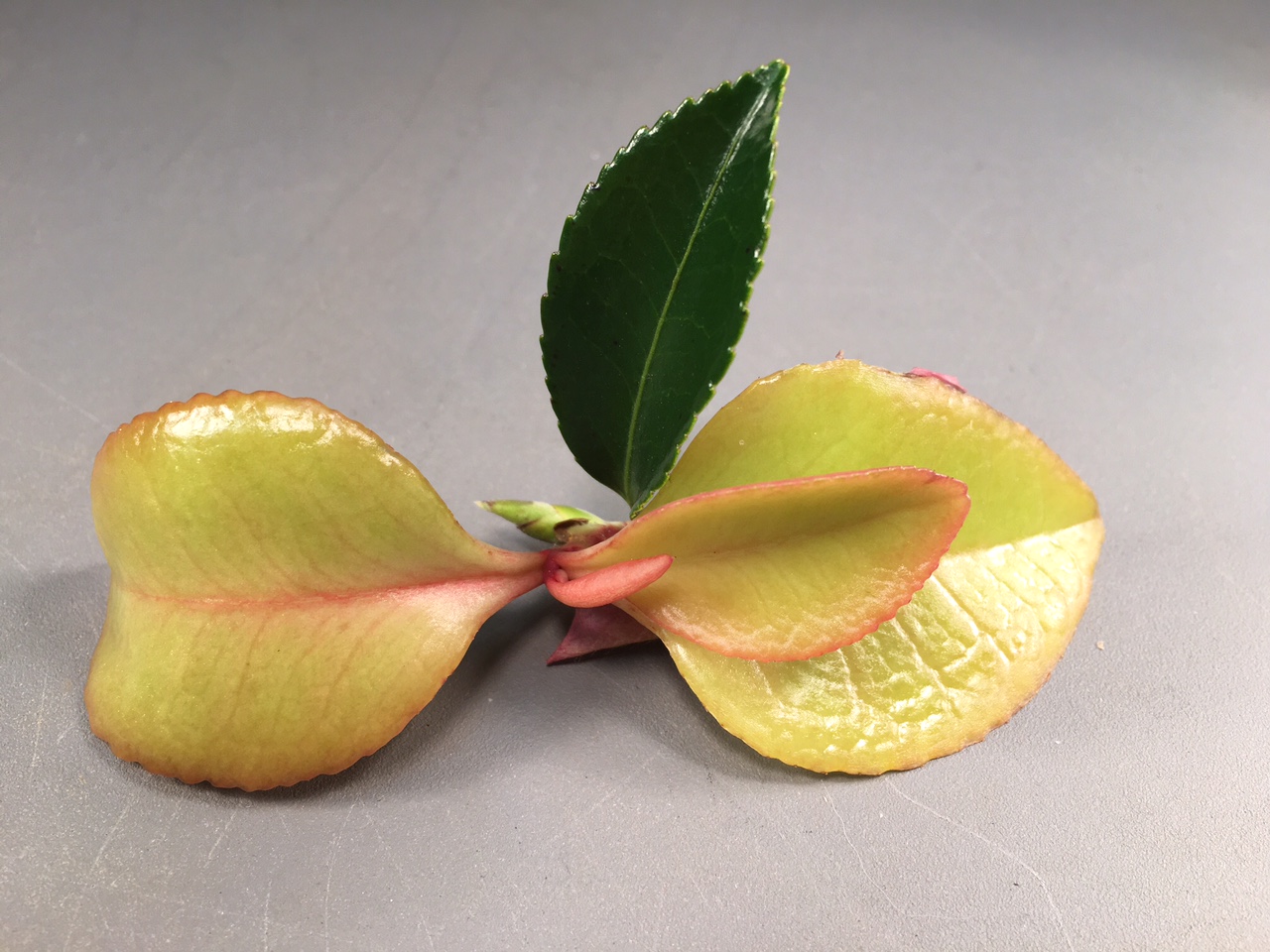
by Mary Salinas | Apr 21, 2016
Recently, a home gardener brought in some strange looking new leaves on his camellia. The youngest leaves were thick and fleshy and looked more characteristic of a succulent type plant than a camellia. What’s wrong with these leaves?
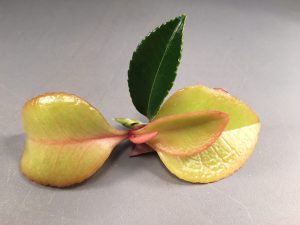
Camellia leaf gall infection resulting in fleshy light green and pink leaves. Note the contrast with a healthy uninfected leaf. Photo credit: Mary Derrick, UF/IFAS.
The culprit is a fungus Exobasidium camelliae whose spores are carried by the wind in search of camellias. This fungus infects camellias, especially sasanquas; it will not infect any other plant species. The disease it causes is known as camellia leaf gall and is most commonly seen here in the Florida panhandle in April. The frequent wet weather this winter and spring created favorable conditions for disease development.
The symptoms of the disease are easy to distinguish and really stand out against the typical dark green leaves of the camellia. Leaves become thick and fleshy and the color ranges from light green to cream to pink. As the disease progresses and the galls mature, the lower leaf surfaces of the leaves will peel away to reveal a white underside laden with fungal spores. Wind and rain will take these new spores to other parts of the camellia or other camellias in the vicinity where they will lay dormant and cause infection the following spring. Eventually the galls will turn brown and dry up.
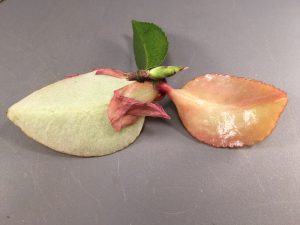
The underside has pealed away revealing white fungal spores. Photo credit: Mary Derrick, UF/IFAS Extension.
Camellia leaf gall is not a serious disease that requires chemical intervention for the homeowner. Simply remove the galls and put them in the trash. The earlier you remove the galls the better; the risk of further infection can be reduced if the galls are removed before the undersides peel and expose their spores. Any that have fallen to the ground can spread the disease and need to be removed.
For more information:
Camellias at a Glance
Camellia Leaf Gall
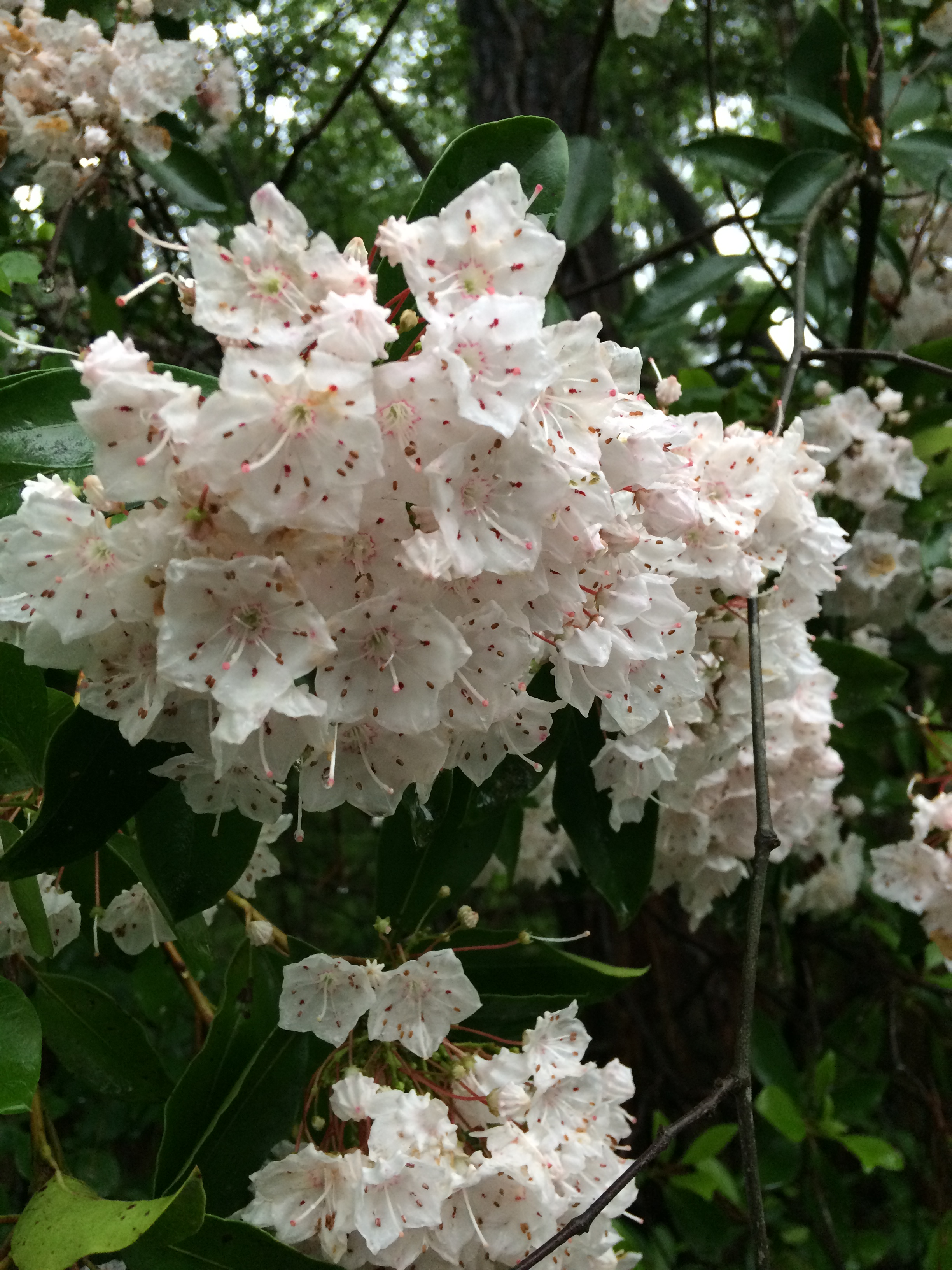
by Sheila Dunning | Apr 21, 2016
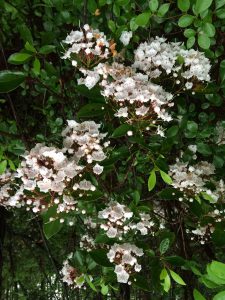
Mountain laurel. Photo credit: Sheila Dunning, UF/IFAS Extension.
If you are lucky enough to live on the southern Alabama edge of northwest Florida, you may want to see if you can find mountain laurel blooming now near the wooded creeks. Its native range stretches from southern Maine south to northern Florida, just dipping into our area. The plant is naturally found on rocky slopes and mountainous forest areas. Both are nearly impossible to find in Florida. However, it thrives in acidic soil, preferring a soil pH of 4.5 to 5.5 and oak-healthy forests. That is something we do have. The challenge is to find a cool slope near spring-fed water.
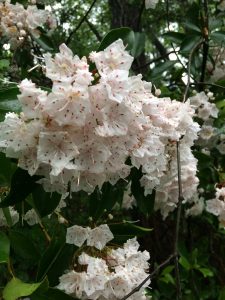
Mountain laurel blooms. Photo credit: Sheila Dunning, UF/IFAS Extension.
Mountain laurel (Kalmia latifolia) was first recorded in America in 1624, but it was named after Pehr Kalm, who had collected and submitted samples to Linnaeus in the 18th century. The wood of mountain laurel was popular for small household items. It is heavy and strong with a close, straight grain. However, as it grow larger it becomes brittle. Native Americans used the leaves as an analgesic. But, all parts of the plant are toxic to horses, goats, cattle, deer, monkeys and humans. In fact, food products made from it, including honey, can produce neurotoxic and gastrointestinal symptoms in people consuming more than a modest amount. Luckily, the honey is usually so bitter that most will avoid eating it.
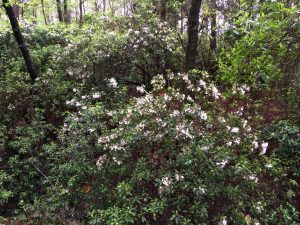
Mountain laurel in its native habitat. Photo credit: Sheila Dunning, UF/IFAS Extension.
One of the most unusual characteristics of mountain laurel is its unique method of dispersing pollen. As the flower grows, the filaments of its stamens are bent, creating tension. When an insect lands on the flower, the tension is released, catapulting the pollen forcefully onto the insect. Scientific experiments on the flower have demonstrated it ability to fling the pollen over 1/2 inch. I guess if you don’t taste that good, you have to find a way to force the bees to take pollen with them.
The mountain laurel in these pictures is from Poverty Creek, a small creek near our office in Crestview. This is their best bloom in 10 years. Maybe you can find some too.
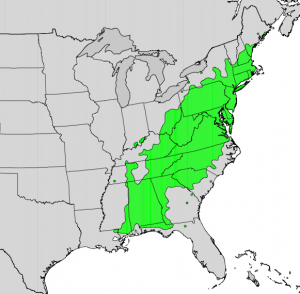
Native range of mountain laurel.
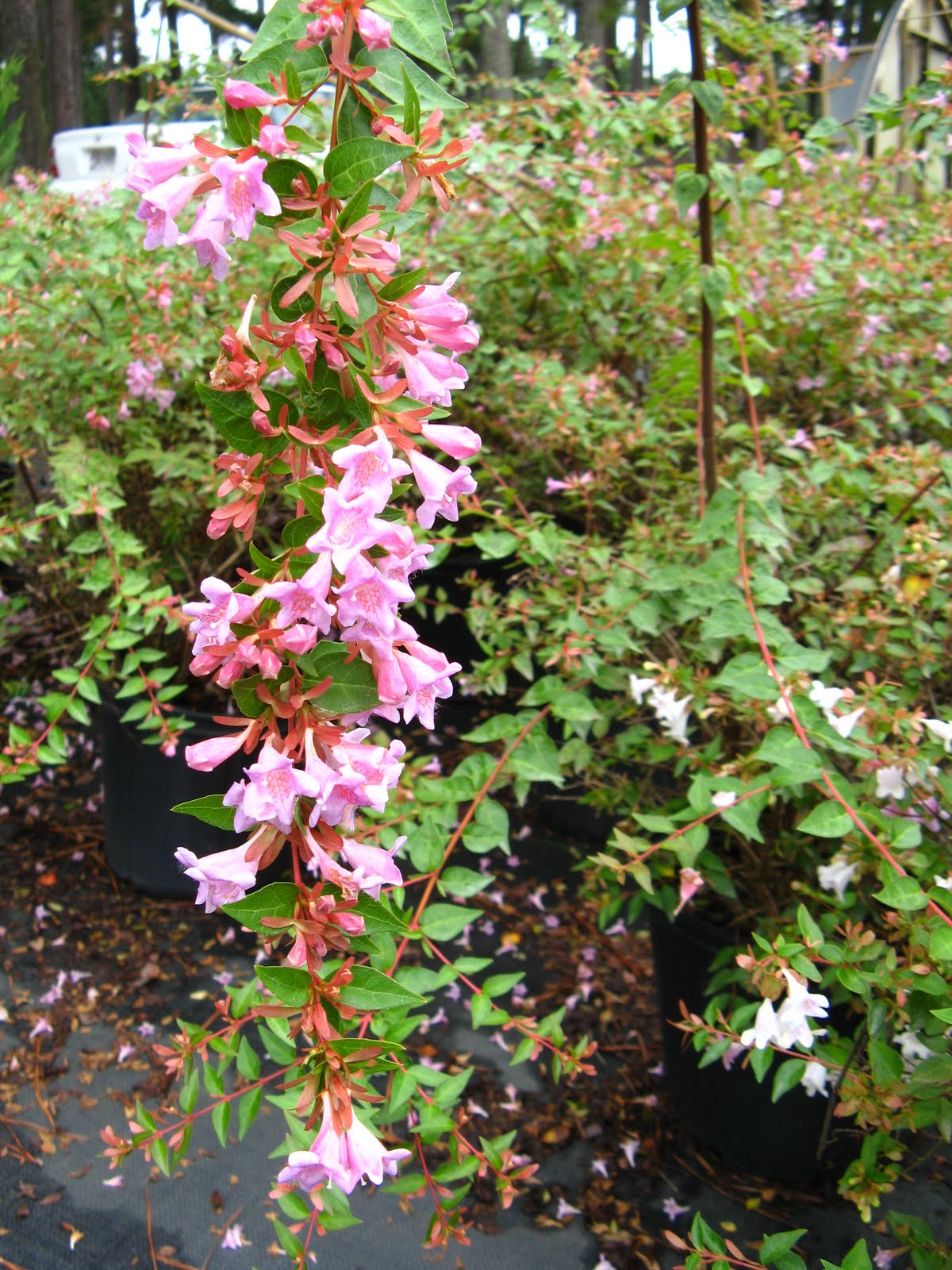
by Julie McConnell | Mar 28, 2016
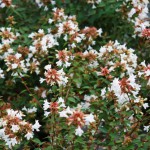
Clusters of tiny white flowers on abelia. Photo: Julie McConnell, UF/IFAS
Abelias have been a landscape staple in the Southeastern United States for over a century. Numerous types have been used over the years, but two of the oldest forms still used in landscapes are Glossy Abelia Abelia x grandiflora and Abelia ‘Edward Goucher’, dating back to the early 1900s.
Glossy Abelia is a large informal shaped shrub with ½ – 1 inch glossy green leaves and large clusters of tiny white flowers. It can grow to 8 feet wide and tall and tolerates tough landscape sites such as full sun, low moisture (once established), acidic or slightly alkaline soils. It blooms prolifically and is attractive to butterflies and pollinators. New stems are reddish colored which contrasts nicely with dark green foliage which may be evergreen if winters are mild. After blooms are spent the pink sepals remain on the plants carrying more color through the season.
‘Edward Goucher’ Abelia does not grow quite as large and is a good performer with pink flowers. It is smaller than Glossy Abelia, but can still reach 5’x5’ when mature. It is also tolerant of hot, dry spots in the landscape.
Over the past few decades there have been many new introductions of abelia cultivars to the market. A major goal of breeders was to offer abelias that would fit into smaller landscapes and there has also been a trend towards variegated foliage color. There are dozens of abelias in production, but a few listed below are usually easy to find in local garden centers and have proven reliable in Florida landscapes.
- Abelia x ‘Rose Creek’ Rose Creek Abelia, low mounding growth habit reaching 2-3’ tall and 3-4’ wide, green foliage, new reddish stems, large clusters of white flowers
- Abelia x grandiflora ‘Hopley’s Lemon Zest™’ Lemon Zest Abelia or Miss Lemon™ Abelia grows 3-4’ tall and wide, has yellow and green variegated foliage, light pink flowers
- Abelia x grandiflora ‘Confetti’ Confetti® Abelia, matures at 3’ tall and wide, new foliage has pink, white, and green variegation and mature foliage is green and white variegated, pink and white flowers
- Abelia x grandiflora ‘Kaleidoscope’ P.P.#16,988 Kaleidoscope Abelia, compact growth 2-3’ tall by 3-3.5’ wide, gold and pink new foliage that matures into gold and green variegation, white flowers
All abelias perform best in full sun to part shade and have low water requirements once established. They are not salt tolerant, so avoid planting in coastal landscapes or in areas where salts are an issue. Abelias have few pest problems, but aphids have been known to feed on new growth – avoid over fertilization.
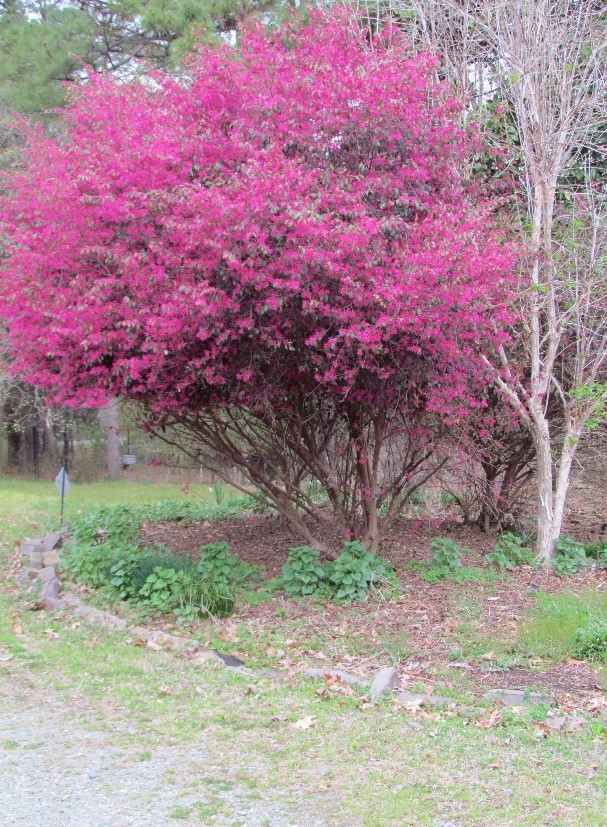
by Daniel J. Leonard | Mar 23, 2016
One of the major issues homeowners face in their landscapes is selecting a tree that in maturity will be in scale with the rest of their garden and home. While we have several actual trees that fit the bill, I would like to focus today on thinking outside the box by selecting a larger growing shrub that we can “limb up” into a small tree!
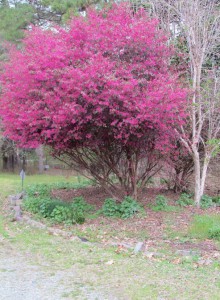
Loropetalum in its tree form
Today’s plant is Loropetalum chinense, also known as Chinese Fringe Flower, a beautiful import related to our native Witchazels (Hammemelis spp.). Some species of Loropetalum can have green foliage and white flowers, but it is generally found in its coveted maroon-foliaged form, which is the subject of this piece. Most cultivars of Loropetalum (with the exception of a few newer ‘dwarf’ cultivars) are large (to 20’ tall and about half as wide) evergreen shrubs that prefer partial shade to full sun. In the early spring, it bursts with wavy, fringe-like red, pink, or white flowers!
In order to “tree-form” the plant, one should gradually begin removing lower lateral branches, crossing or rubbing branches, and any potentially diseased branches, leaving 5-7 main trunks. Eventually, most common cultivars of Loropetalum can easily be pruned to have 4’-5’ of exposed trunk!
Unfortunately, Loropetalum has been both overused and misused as a tightly sheared foundation plant in every landscape imaginable, from gas stations to Aunt Gertie’s rental house. As such, it has gotten a bad reputation as a monster that has to be constantly sheared to keep it in line. This reputation is completely unwarranted if using the shrub as it was meant to be used, as a large specimen shrub or a graceful small-tree! Yet another example of how using the right plant in the right place can change the public’s entire perception of it! Try tree-forming a Loropetalum today and enjoy it for years to come! Happy Gardening!
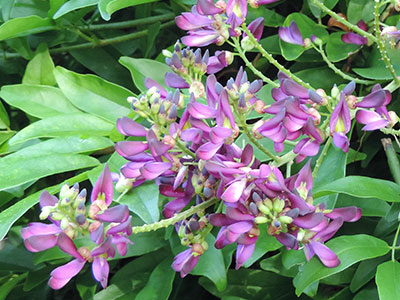
by Matt Lollar | Mar 22, 2016
Are you looking for a way to jazz up a fence, trellis, or arbor? Are you looking for year-round color in your garden? Are you looking for wonderful, fragrant blooms in the summer? Than evergreen wisteria (Millettia reticulata) may be the right plant for your place!
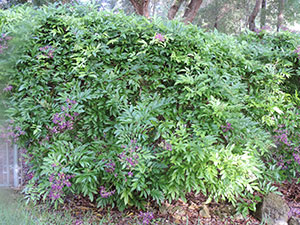
Evergreen wisteria growing on a fence. Photo: University of Florida/IFAS
Evergreen wisteria is not only a beautiful vine, but it is an excellent alternative to that pesky, invasive Chinese wisteria. Sometimes referred to as summer wisteria, this plant is native to China and Taiwan. As you may have noticed by its scientific name, Millettia reticulata, is not a true wisteria but it is in the same plant family, Legumaceae or the bean family.

Evergreen wisteria in bloom. Credit: University of Florida/IFAS
Evergreen wisteria is a woody vine that has glossy, thick green leaves and clusters of small, fragrant, purple flowers. The plant can reach a height of up to 30 feet, but can easily be controlled with pruning. It blooms in the summer, and often into the fall, with deep purple, pea shaped blooms. Although its common name states it is evergreen, it is often semi-evergreen in the Panhandle. Evergreen wisteria grows best in full sun, but can tolerate partial shade.
Evergreen wisteria can tolerate a wide range of soil pH as long as the soil is well-drained. It is a twining vine and may need a little help to start growing on a structure. It can be left alone to climb tall structures like pergolas and arbors, but you may want to selectively prune the plant to encourage it to leaf out at its base when training on a trellis or fence. Deadheading (removing spent blooms) will encourage an elongated bloom season.
Evergreen wisteria can help add an additional visual dimension to your landscape and it won’t invade your space like its distant cousin.
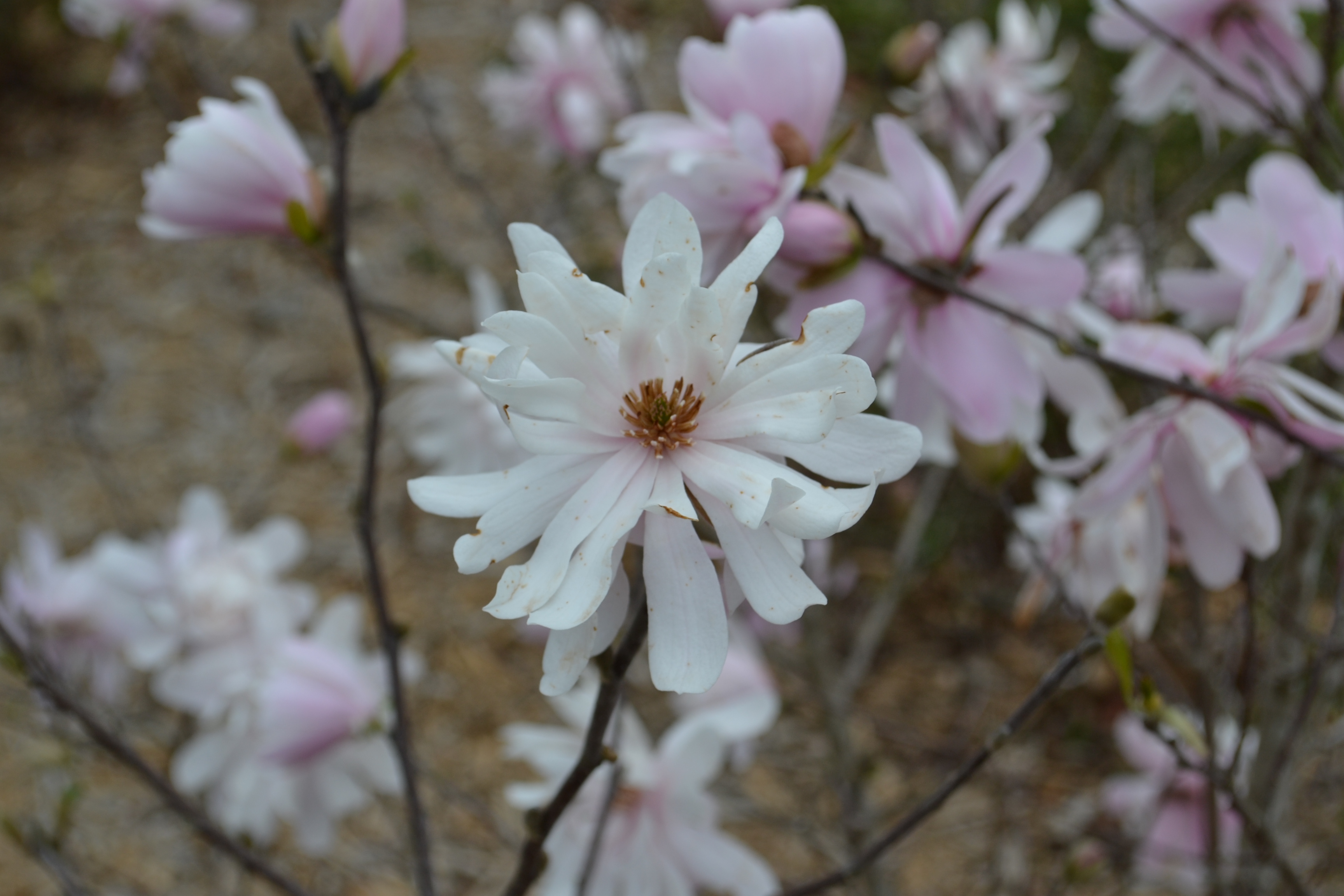
by Beth Bolles | Feb 24, 2016
Magnolias are well known plants to gardeners and many are familiar with the foliage and flowers of these plants. If you are looking for another earlier bloomer, you may want to consider adding a specimen selection to your landscape, the Star magnolia (Magnolia stellata).
Although not native to the United States, star magnolia is a slower growing multi stemmed deciduous shrub reaching about 15 feet in height over time. The best feature are the bright whitish pink star-shaped blooms appearing in late winter before leaves emerge. The flowers offer gardeners a peek of the spring to come and remind us that our Gulf Coast winters are not that long. 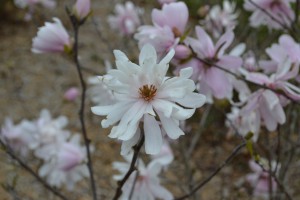
Plants do best in soil with some organic amendments and mulch over the root systems. A planting area that receives a little afternoon shade is ideal but established plants will adapt to sunnier locations when irrigation is provided during drier weather. Only occasional pruning is required to remove crossing branches or those that grow out of bounds. Prune after flowering if needed.
















